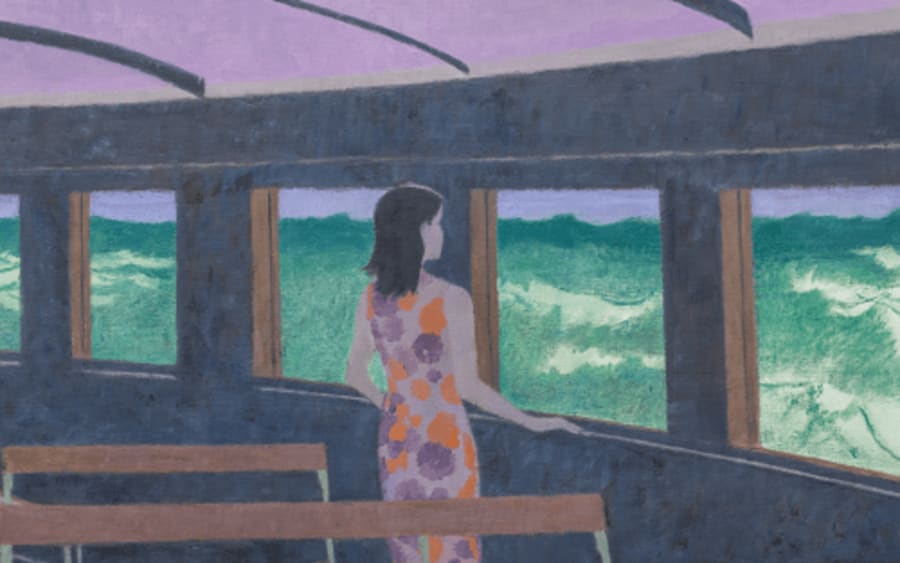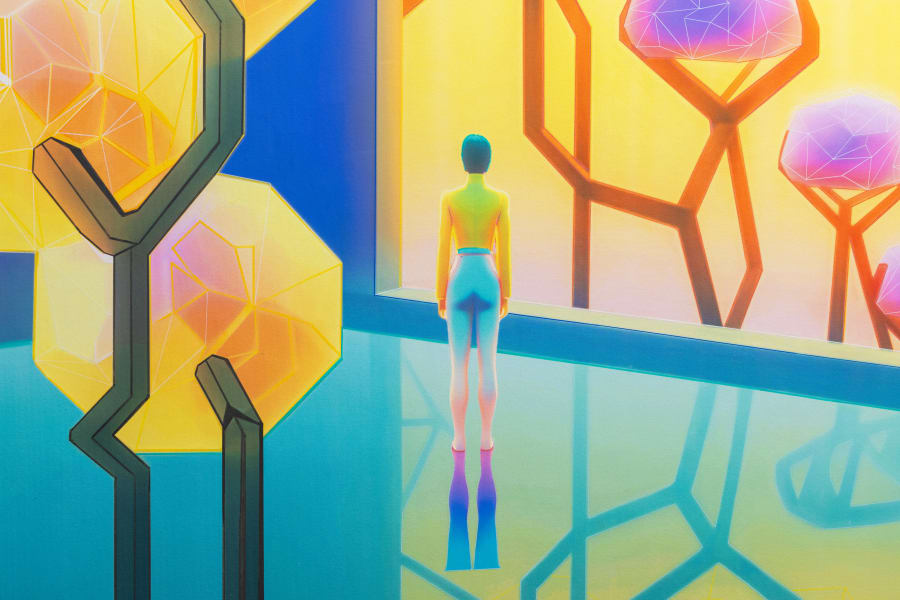A 'Chinese post-pandemic spending euphoria' helped buoy the global art market in 2023, according to the latest Art Basel and UBS Art Market report. How did this trend play out in the Hong Kong Spring auctions? At Sotheby’s, Poly Auction, and China Guardian, where auctions took place at the beginning of April, buyers continued to exercise greater caution compared with pre-COVID years, in line with the global art market. However, certain green shoots were in evidence: blue-chip works from renowned collections remain attractive, new buyers from Europe and the US were in evidence, and Sotheby’s held an inaugural ‘Now’ auction, signalling that the interest in the ‘ultra-contemporary’ market continues. Elsewhere appetite for Chinese ceramics remained buoyant, as did it for Buddhist art.
Sotheby’s Modern and contemporary evening sales took place on April 5, and for the first time in Hong Kong included a ‘Now’ auction – a sign that interest in the so-called ultra-contemporary market is not abating. Those sales raised a combined HKD 673.4 million (USD 87.5 million). The equivalent Modern and contemporary sales last year fetched considerably more, also due to the fact that there were more lots on offer: HKD 1.1 billion (USD 147.6 million) from 81 lots. Meanwhile, last autumn’s Modern and contemporary evening sales raised HKD 554.7 million (USD 70.8 million), though a cache of works from the Long Museum, offered the same evening, raised a further HKD 545.6 million. As Alex Branczik, Sotheby’s chairman of Modern and contemporary art in Hong Kong, puts it: ‘We are in a different market today.’ However, he notes that, though values are down compared with spring last year, ‘many top tier global collectors — from Europe, North America and Asia — participated in our Hong Kong sales for the first time in a long time.’
Christie’s will hold its spring auctions at the end of May ahead of its move in September to new regional headquarters in the latest Zaha Hadid addition to the Hong Kong skyline, a modular building called The Henderson. The outlook at the auction house remains optimistic. According to Francis Belin, Christie’s Asia-Pacific president, the response from collectors to Christie’s sales in Asia and internationally ‘has been robust in the first quarter [of 2024].’ He notes that the auction house’s Asian Art Week in New York totaled close to USD 52 million, with particularly strong results for South Asian Modern and contemporary art, which was 100% sold and realized 310% of the low estimate. ‘Here in Hong Kong, our online sales have achieved solid sell-through rates across both art and luxury,’ he adds. ‘What remains clear is that object quality, compelling sale curations, and realistic pricing strategies continue to attract this market, all of which will underpin our Hong Kong spring auctions in May.’
Spending from Mainland China was up in the first half of 2023, according to the latest Art Basel and UBS Global Art Market Report 2024, with collectors here registering the highest median expenditure in the first six months of last year, at $241,000. Demand was particularly strong for painting, up 20% from 2022, and was four times the average. But, as the report noted, China was just out of a prolonged pandemic-induced lock down, and the pent-up energy was particularly evident in sales for the first half of the year, which slowed down by the time of the autumn auctions.
This spring, Sotheby’s continued to report strong interest from buyers from the People’s Republic of China, Hong Kong and Taiwan, and from North America. Some of the names that have been attracting the most attention in Hong Kong over the past few years saw the highest prices and sold most swiftly. I Want to See the Bright Lights Tonight, a 2017 painting by Japanese artist Yoshitomo Nara was the top lot in the Modern and contemporary evening auction, although it barely scraped its low pre-sale estimate of HK$80m, selling for HK$81m. Interest in Nara’s work has been consistent in recent years, and this particular piece went to an unnamed bidder from London over the phone. For the first time ever, Hong Kong is paying attention to a painter from the Chinese diaspora, Wifredo Lam (1902-1982), the Cuban modernist painter of Chinese descent, whose 1969 Les Fruits tropicaux was sold for HK$11.3m (US$1.4m), a record for the newly appreciated artist.
Chinese ceramics remain one of the highlights of Sotheby’s spring auctions, with a European collection acquired from the late Edward T. Chow, one of the most renowned collectors in the field, going under the hammer. The works on offer ranged from exquisite monochromes from the Ming (1368-1644) and Qing dynasties (1644-1912) to intricate wares from the Qianlong period (1733-1799). Nicolas Chow, Sotheby’s chairman and worldwide head of Asian art, noted how this collection had not been seen on the market for more than 50 years. Accordingly, sales fetched higher-than-expected prices, with a very rare guan glazed octagonal bottle, from the Song dynasty (960-1279) or later, selling for HK$20.4m (US$2.6m) against an estimate of HK$8m to HK$12m. A fine and rare ge type cup, with a highly crackled glaze effect, sold for HK$5.5m (US$697,000), many times above its estimate of HK$600,000 to HK$800,000. Yongzhen era lychee cups also sold for more than ten times the highest estimate, for more than HK$8m (above US$1m) confirming Hong Kong’s great appetite for imperial wares, in particular ceramics.
Poly Auction Hong Kong also had their sales at the same time, at the Grand Hyatt Hotel, and the auction house reported total sales (including private deals) of HK$330m (US$42m), of which HK$292m sold publicly. Last year’s autumn sales fetched slightly more than HK$313m (US$40m). Fiercest bidding was elicited for Zhang Daqian (1899-1983), sometimes dubbed “China’s most popular artist”, whose Misty Clouds at Mount Ali, a late painting produced one year before the artist’s death, fetched HK$10.8m, a record for the artist.
The atmosphere at the preview was subdued, however, with fewer viewers than in previous years. This may partially be due to the fact that Poly had fewer works on the block—60 pieces in the Modern and contemporary section, compared with 95 in 2023. The highest selling work in this section was Yayoi Kusama’s Red Pumpkin (1989), which sold for HK$18m (US$2.3m), confirming the steady interest in the Japanese artist.
In a return to more traditional media, viewers and buyers were particularly interested in Chinese painting and calligraphy—the total figure for these lots was HK$60m (US$7.6m). In comparison, last year’s total Spring sales figures for Chinese painting and calligraphy was HK$23.5m, while the autumn total for this category was HK$57.3m. Poly offerered a series of lots under the title “Unique Existence in True Void: The Highlights of Buddhist Art”, a grouping that generally sold above expectations, notably the Ming dynasty painter Dong Qichang (1555-1636) whose Calligraphy in Running Script sold for HK$ 2.16m (US$276,000). The auction also offered a vast array of ancient painted and calligraphed fans and other minor items, but the auction house lamented a “high number of withdrawn lots” without specifying exact figures. Yan Xu, the head of the Chinese painting and calligraphy department at Poly, said that the withdrawals, coupled with “conservative pricing, indicate that a full rebound of the art market remains elusive”. Most works didn’t surpass their high estimate.
The third auction house to hold sales in the same week as Poly and Sotheby’s was China’s Guardian, which also reported that more than ten lots had been withdrawn prior to sales. All lots comprised Chinese art, with only a small section on contemporary painting and calligraphy. The most significant sales registered, according to the auction house’s website, were for a Yixing teapot from 1992, inscribed by Han Meilin and from a Taiwanese collection, which fetched HK$8.34m (more than US$1m), over its high estimate of HK$7m. Also from Taiwan, from the Fengya-tang collection, a rare archaic jade phoenix sold for HK$18.6m (close to US$2.5m), an exceptionally high price for a piece of this kind, and more than two and a half times the high estimate. Among the Chinese painters, Zhang Daqian confirmed his star-status, with Lady Amidst the Verdant Silk (1938) selling for four times the high estimate, for HK$4.860m (US$620,000). Qi Baishi (1864-1957), meanwhile, topped the sales for with Rooster (undated), which went for HK$2.2m (nearly US$1m).
Among the slight follies of the auction, Guardian sold the First Ever Chinese RWA Digital stamp: Year of the Dragon Gold Editions. RWA stands for Real World Asset, or the digital representation of a hard asset. This digital stamp fetched three times its high estimate, selling for HK$1.3m (US$168,000).
Gimmicks aside, the spring auctions confirmed what the latest Art Basel and UBS Art Market Report 2024 already suspected, that collectors, buyers and investors in the region are not feeling the same kind of giddy desire to spend and bring home extravagant treasures that characterised the pre-Covid years. In part this is a sign that over-investment in real estate, and the sluggish internal consumption in the Chinese market, are having real time effects on the larger luxury and art trades. But, as other global markets have shown, demand remains strong for tried and tested names—whether Modernists such as Qi Baishi and Zhang Daqian or more contemporary names including Yayoi Kusama and Yoshitomo Nara. Exceptional and rare antique lots will find eager buyers, too.
Download the Art Basel and UBS Art Market Report 2024 here
Caption for top image: A visitor in front of a work by Li Huasheng, presented by Ink Studio at Art Basel Hong Kong 2024.
Ilaria Maria Sala is a writer and journalist based in Hong Kong.
Published on April 25, 2024.


